Chillingham Castle – A Visitors Guide
Wondering about visiting Chillingham Castle? Not sure if it’s for you? Read my complete guide on visiting Chillingham Castle to find out more.
Many castles litter the county of Northumberland. Relics from a turbulent past which saw Roman occupiers guarding a walled frontier, Anglian invaders fighting with Celtic natives and Norman lords building castles to defend the border with Scotland. Chillingham Castle is a 12th-century stronghold that is most famous for being one of the most haunted places in the world.
Taking advantage of a Groupon offer, we bravely visited.
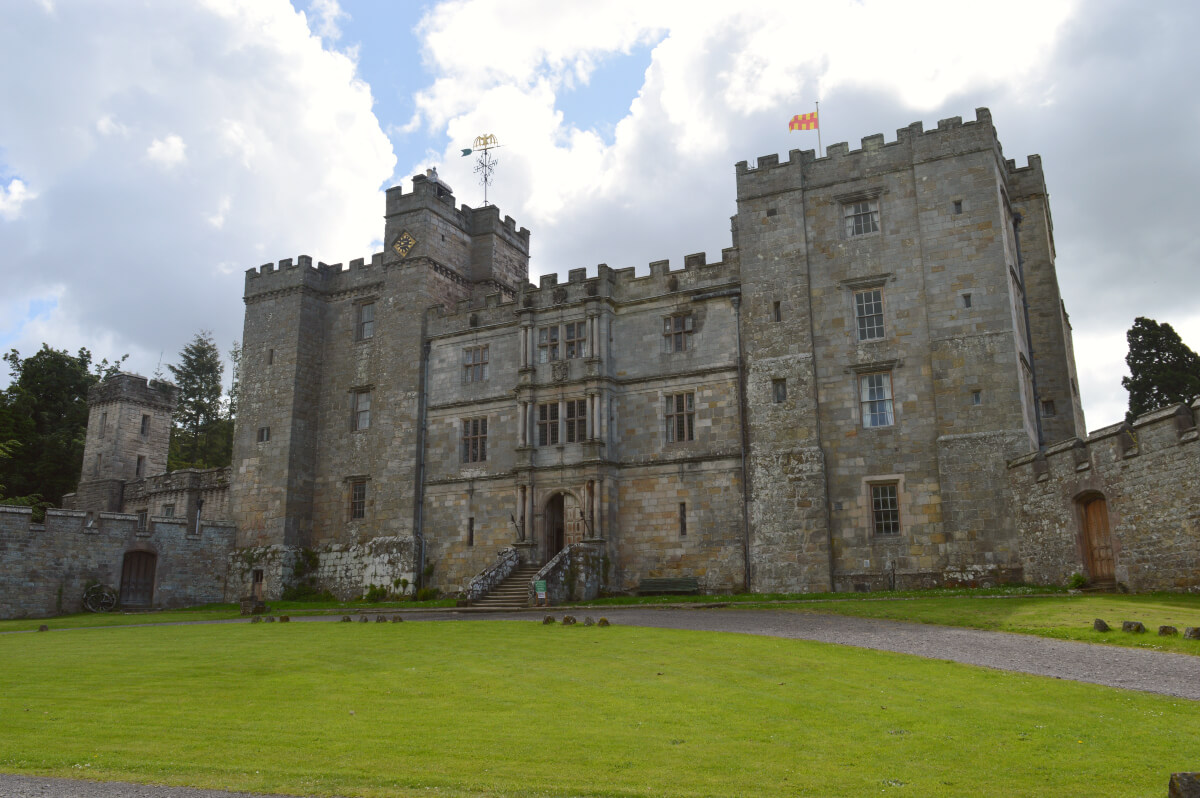
Table of Contents
- Who owns Chillingham Castle?
- History of Chillingham Castle
- Inside Chillingham Castle
- Chillingham Castle Gardens
- The Ghosts of Chillingham Castle
- Where is Chillingham Castle?
- Parking
- Opening Times and Prices
- Chillingham Castle Accessibility
- If you enjoyed this …
Who owns Chillingham Castle?
Chillingham Castle is a privately owned castle that has been in the same family for over 800 years. The castle was the seat of the Grey family (of Earl Grey tea fame) from the 13th century until the 1980s. Sir Humphry Wakefield owns it now and he has lovingly restored it from ruins.
Sir Humphry’s wife is a Grey by descent so the castle’s connection to the Grey family remains. His daughter, Mary Wakefield, is married to Dominic Cummings.
History of Chillingham Castle
Chillingham Castle began life as a monastery in the 12th Century. The original manor house was destroyed in a Scottish raid in 1246 and was replaced by a tower house, which remains as one of the four corner towers today.
The castle became a fully fortified medieval castle in 1344 when they got royal permission to add battlements. In Tudor and Stuart times it was refurbished and redeveloped.
Being close to the Scottish border, Chillingham Castle bore the brunt of many Scottish attacks. In 1297, William Wallace attacked the castle, burning women and children to death in the monastery. In 1298 King Edward I chose Chillingham Castle as the base of his campaign against Scotland. The room he stayed in is said to be particularly haunted.
The castle has seen many royal visitors including King Henry III, James I and Charles I.
Inside Chillingham Castle
Chillingham Castle stands on 1,500 acres of Chillingham Park. Chillingham Park is unique as it has 330 acres where the Wild Cattle of Chillingham roam. These are a feral herd of medieval oxen, which live freely, untouched by the hand of man. The Chillingham cattle are a separate visitor attraction but you can buy joint tickets.
It is a short stroll from the car park through the grounds. The castle looms in front of you from a distance.

Making our through the grounds to the castle entrance we went inside.


Chillingham Castle is a castle not like any other. The castle has a long history, and every room is full of antiques and eccentric artefacts that reflect the owner’s interests and family history. It is an eclectic mix of old and new which gives the castle a distinctive quirkiness and charm. It is not like a visit to a National Trust or an English Heritage property.
Still Room
The first room we went into was the still room. This room contains a mix of artefacts and family history. A large cooking pot for feeding the castle garrison hangs on the wall and one for pouring boiling oil over invaders. Photos of the family are on the shelves, one shows Sir Humprey’s great uncle Arthur who nearly reached the summit of Everest. Watch out for the picture of the witch who will curse anyone who steals from Chillingham Castle. There are letters to prove this is not a joke.


Medieval Courtyard
Access to the rest of the castle is via the medieval courtyard, with the different towers standing on each side. It is imposing and you gain a real sense of history as you walk across the stones. Once you enter the castle a one-way system is in operation, taking you around the castle so you don’t miss anything.

Chillingham Castle’s Great Hall
Walking into the great hall you get a feeling that you are in a real medieval castle. Tapestries and flag hang from the walls. Weapons are on display, ready to grab if an attack happens. The banqueting table stands ready for the feasting, while a roaring fire flickers in the fireplace.
The great hall is Elizabethan and was built for the royal visit of James VI of Scotland.


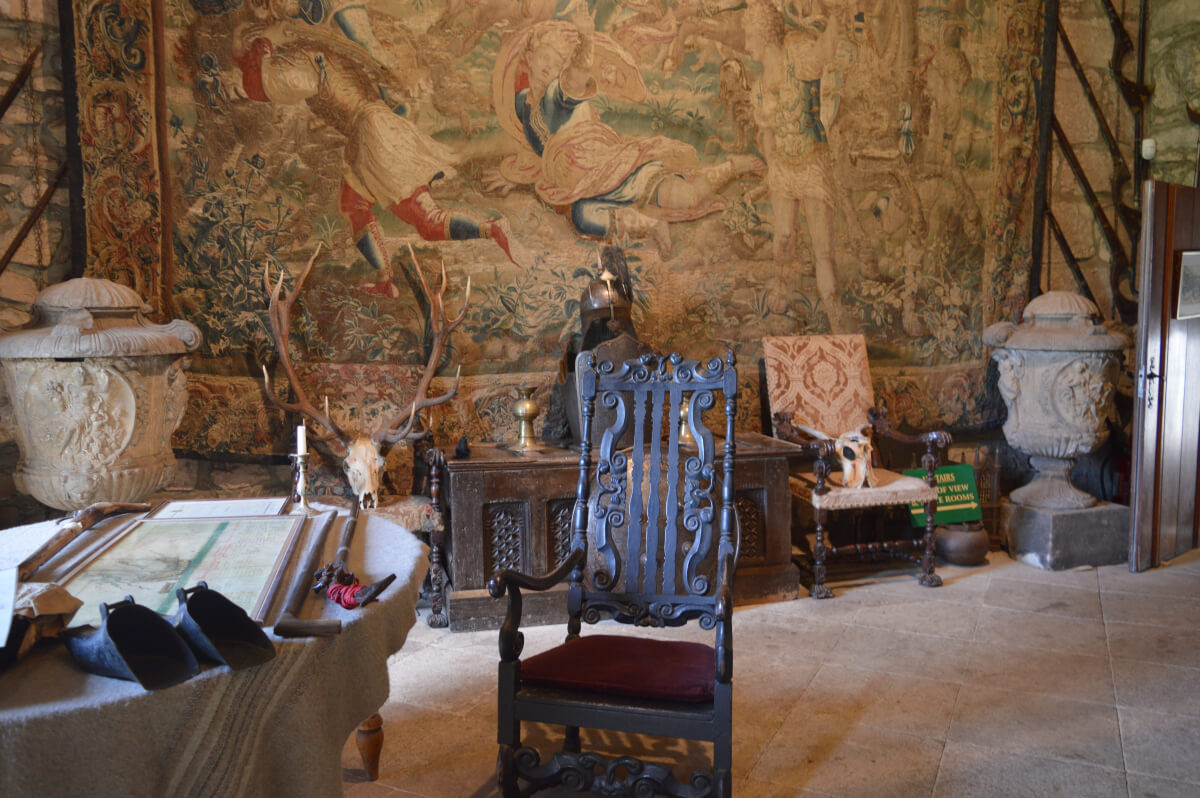
The Stairs and the Pink Room
Leaving the Great Hall you go up a set of winding narrow stairs that are almost a museum. Different objects line every spare corner, you never know what you might spot next.

You also get to peep into the castle’s Pink Room. One of Chillingham Castle’s ghosts, the Radiant Boy, appears in this room. You don’t want to be in it at midnight. As the clock strikes, the cries of a child in pain echo from the passage into the tower. As they fade, a light appears and a figure of a boy dressed in blue approaches the bed.
During work in the bedroom, the bones of a young boy and scraps of blue cloth were found. Legend says he discovered documents relating to the Spanish Invasion of 1588 and was bricked up alive with the papers to ensure his silence.
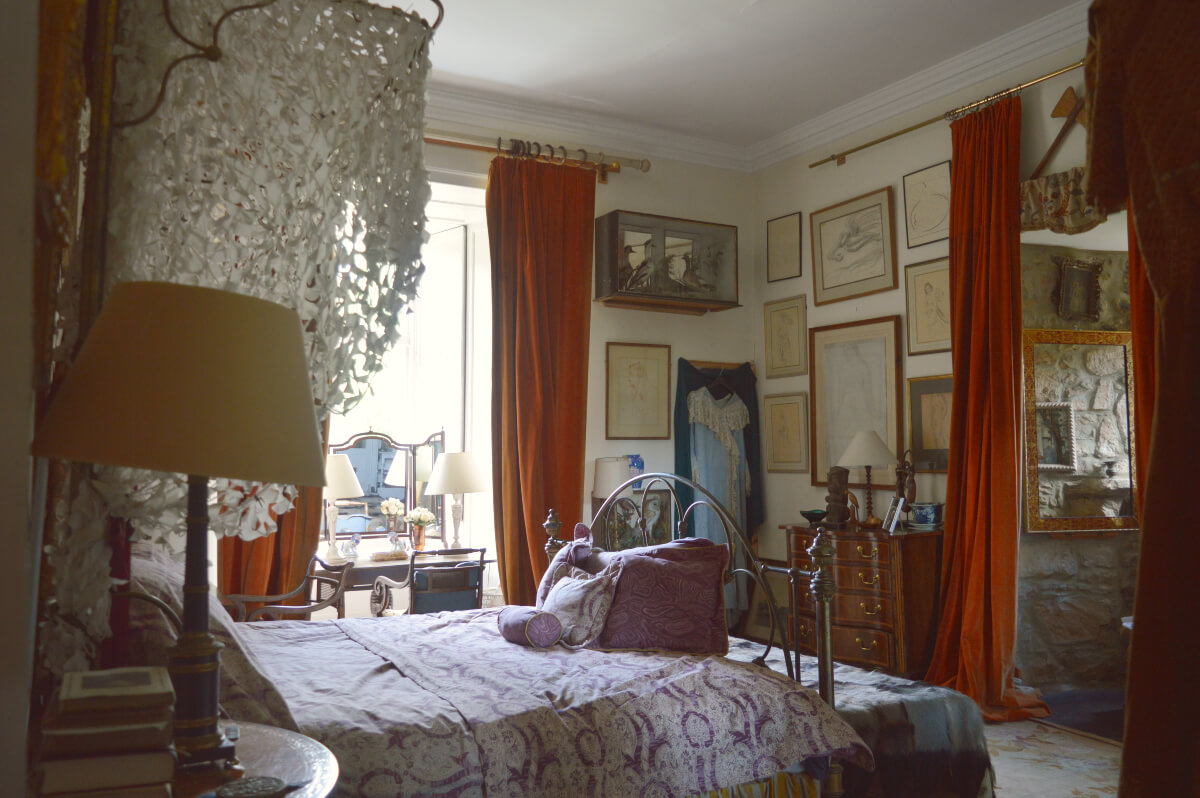
As you climb the stairs you will also see a fossilised bullhead, from the same family as the Chillingham wild cattle.


The Roof Garden Lookout
The stairs take you out to the roof garden lookout, the Northumberland flag flying from the flagpole. Here you get a lovely view out over the Cheviot hills and the 19th Century gardens, designed by the Royal gardener Sir Geoffrey de Wyattville in 1828.


Edward I Room
The oldest room in the castle is the Edward I Room. This is a 13th-century room with armour and weapons of the time on display. It is fascinating to touch the armour and realise how heavy it is. The room also displays the royal permission to build battlements, or ‘license to Crenellate’ on the wall.
The room takes its name from a visit from Edward I, Hammer of the Scots. During his stay, the dungeons began to fill with Scottish prisoners. The room hid many secrets. More than 100 Elizabethan documents had been hidden in a hidey-hole near a window and were found during renovations. Some relate to the Spanish Armada, others to the succession of James VI of Scotland.


King James I Room
Moving forward in time we step into the King James I room which got its name from the King’s visit in 1603. This is one of a suite of three rooms. It is really elegant with a gilded ceiling and patterned silk. You can imagine the king relaxing here.



The Plaque Room Library
The second in the suite of three rooms is the Plaque Room Library. This is full of family memorabilia. Look for the photographs of the visitors to the castle over the years, it is fascinating. The titles of the books in the library make for interesting viewing.


The New Dining Room
During the time of King James, this would have been a room where the king would wash and sleep. The royal latrine was on the tower stairs. Now it is a grand dining room, set ready for people to eat. Many famous guests have eaten here, including Prince Phillip.

The Museum / Attic
The museum is in the attic and is full of surprises, family history and collections. There is something different in every corner, from a collection of school uniforms, old rocking horses, weaponry and teddy bears.
A lot of it relates to the family history, you can see a photograph of Sir Humphry’s great uncle in the hydroplane he built whilst pioneering flight from water and a model of the plane hangs overhead. You can spend ages browsing, there is so much to see and discover.




The Chapel
The chapel is still in use for Wakefield family services today. At one time it was a library but it’s now back to its former glory. It is a peaceful place, in stark contrast to the dungeons.

The Minstral’s Hall and Tearoom
Before leaving the castle you enter the Minstal’s Hall which contains the tearoom. The Minstrel’s gallery overlooks the hall where log fires burn. Decorating the hall are spears, tapestries and banners. A giant prehistoric elks head hangs on the wall.

The tearoom serves refreshments at a reasonable price. Choose from a range of sandwiches and toasties which are all around £5.
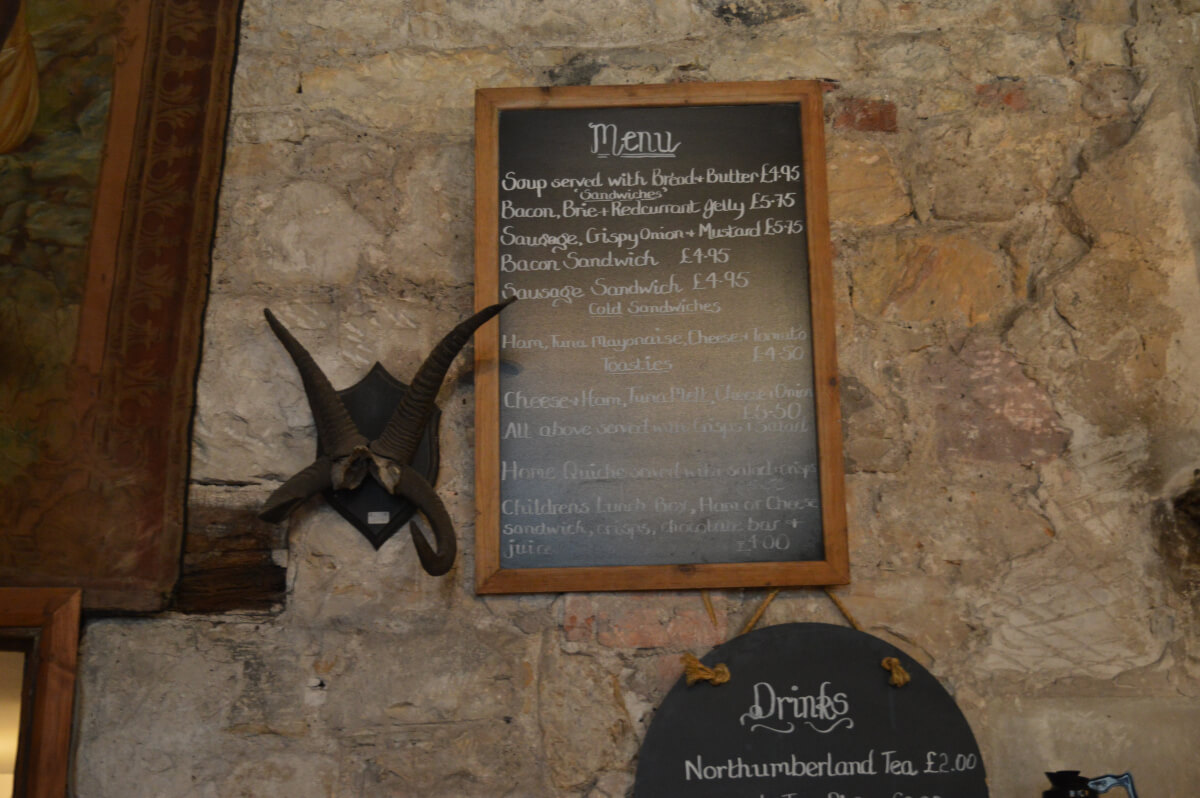
Berthele
Chillingham has been occupied since prehistoric times. In the Iron Age, there was a fort at Chillingham on the nearby Ross Hill. In the Second World War, a German POW, Fritz Berthele found flint and antler arrowheads and axes dating to the bronze age. The Berthele room features these discoveries and gives an insight into the local tribes in the prehistoric Chillingham Castle.
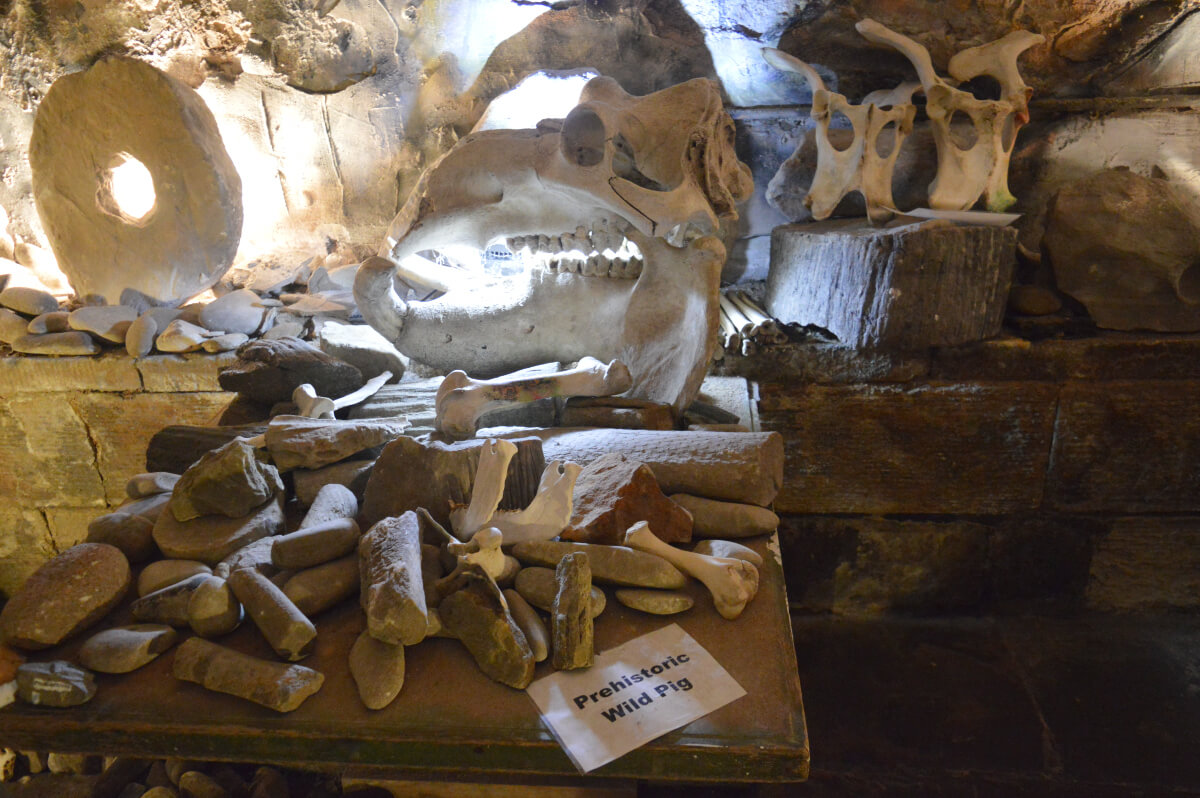
Chillingham Castle Dungeons
The Chillingham Castle dungeons are a grim and chilling reminder of the castle’s bloody history. During the First War of Scottish Independence, the dungeons were full of Scottish prisoners. Edward I appointed John Sage as a torturer. Over the three years of war, he would torture 50 prisoners a week. A total of 7500 prisoners died here.
At the end of the war, the remaining prisoners were burnt alive in the grounds, their children watching from the Edward Room. Later John Sage took an axe and hacked the children to death. It is a chilling reminder of the past.
The dungeons display the graphic instruments of torture, featuring a stretching rack, cages, a bed of nails, a nailed barrel and a spiked chair. Be careful, my son nearly sat on the chair before realising. I love the humorous note on its top.



Chillingham Castle Gardens
The gardens are the inspiration of Capability Brown and are the work of royal designer Sir Jeffry Wyatville. In medieval days the garden was a tiltyard where ladies would sit to watch their knights jousting. Now there are neat hedges, rose bushes and hidden fountains. It is relaxing to walk around.
Beyond the gardens stretch the grounds with woodland walks and lakes. If you are lucky you might catch a glimpse of a deer or a red squirrel. There is also a chance to go fishing on the lakes which are home to many species of trout.






The Ghosts of Chillingham Castle
It is not surprising that Chillingham Castle is haunted given the amount of suffering it has seen over the years. If you are brave you can sign up to go on a ghost tour, or even stay in the castle overnight.
The King Edward room is one of the most haunted rooms in the castle and many visitors report an overwhelming feeling of fear and sadness. This is not surprising as this is where the children of the Scottish prisoners saw their parents being burnt alive in the courtyard, before being killed in this room with an axe.
The ghost of the radiant boy lingers in the pink room and another unquiet soul is the Grey Lady. This is the spirit of Lady Berkeley, wife of Lord Grey. Her husband ran off with her sister, Lady Henrietta. She was left abandoned at the castle, with only her baby daughter for company. You can sometimes hear her dress rusting as she searches for her husband, leaving a cold chill in her wake.
These are just a few of the ghosts that haunt the inside of the castle. The grounds themselves also have ghostly visitors. The lake looks peaceful but beneath its surface is a graveyard where Scottish prisoners were thrown. Legend says that the lake has a curse on it and if you put your hand on it the souls who linger there will pull you down.
In the woodlands stand the hanging trees where prisoners would be hung. They were left hanging to die of thirst and hunger and their bodies were left to rot.
Where is Chillingham Castle?
Chillingham Castle is in the village of Chillingham, Northumberland. It is approximately 13 miles north of Alnwick and 19 miles south of Berwick.
Chillingham Castle,
Chillingham,
Alnwick,
NE66 5NJ
The castle is clearly marked from the A1. Take the Chatton/Wooler road, a few hundred yards north of the Purdy Lodge/Bambrough turn. The castle is also clearly marked from the Newcastle/Wooler A697 near Wooler.
Postcode for your satnav: NE66 5NJ
Parking
Free parking is available on-site. Follow the signs from the main gate. Disabled parking is adjacent to the castle.
Opening Times and Prices
Chillingham Castle is open from Easter until the end of October. Visit the Chillingham Castle website for the exact dates and current prices.
Opening times are from 11 am until 5 pm daily. The last admission is at 4 pm.
When this was written the entrance prices were:
- Adult: £10.50
- Concessions: £9.50
- Children (under 16): £6.50
- Family ticket (2 adults and 3 children): £26.00
Check the website for up-to-date information.
Chillingham Castle Accessibility
Dogs are not allowed in the castle or ground except for Guide and Assitance Dogs.
The uneven floors and steep spiral staircase makes disabled and buggy access limited.
If you enjoyed this …
You might also like:
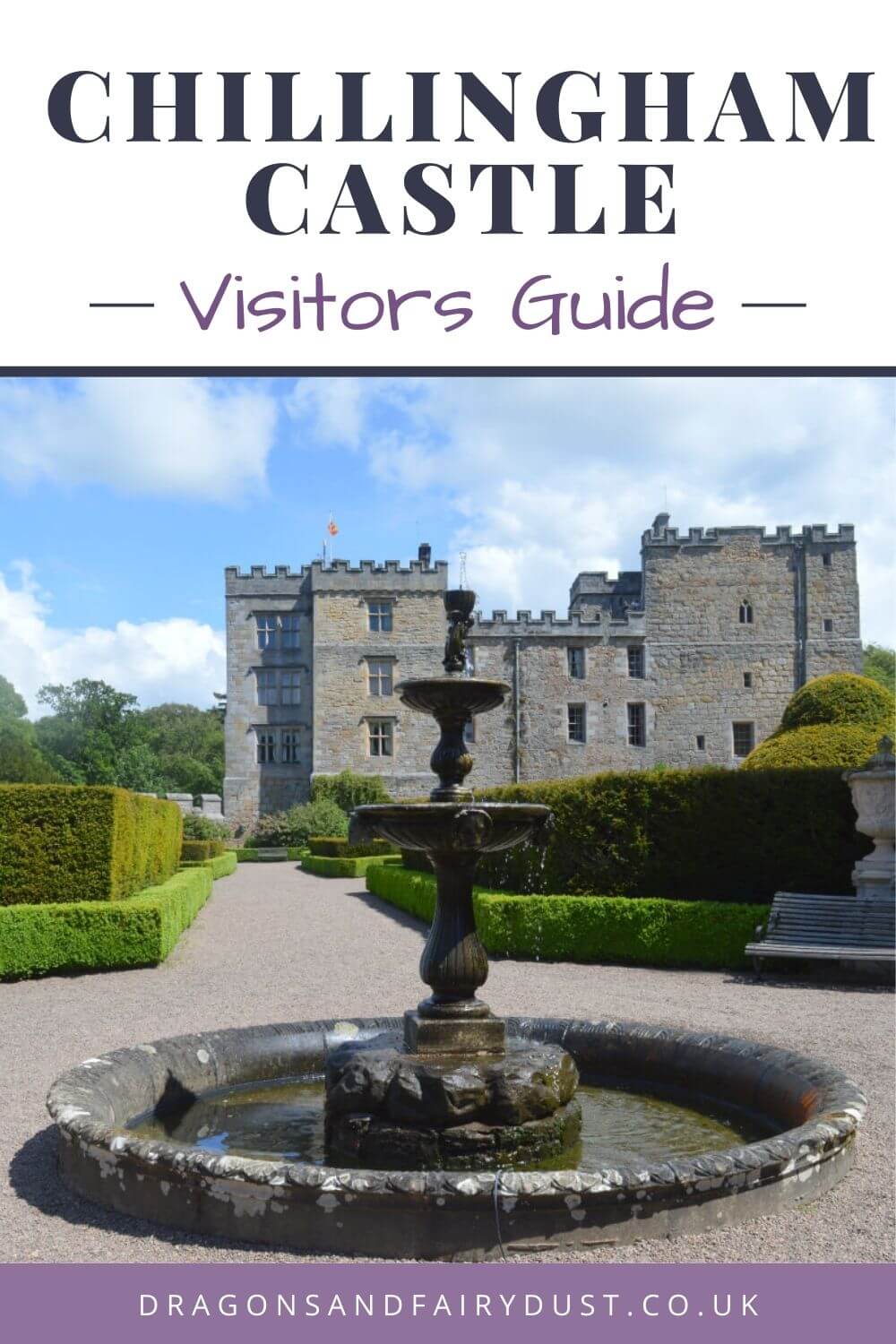







Oooh I remember seeing this on an episode of Most Haunted ! It looks like a fascinating place. So much to see and so much history 🙂
It really is fascinating. Fortunately we didn’t meet any ghosts
Great photos! I can see how a visit to Chillingham might be fun, but it’s sad that the medieval rooms look rather kitschy, filled with nice things, but put together in a way that makes them look like rooms in a medieval theme park or restaurant. Why not have a least one early room furnished as it would have been?
I have been a paranormal investigator for 15yrs, but location’s like this “No ghosts are needed, the castle alone will be fascinating to visit/stay. Any place where kid’s are stuck, are the saddest kind of a haunting.